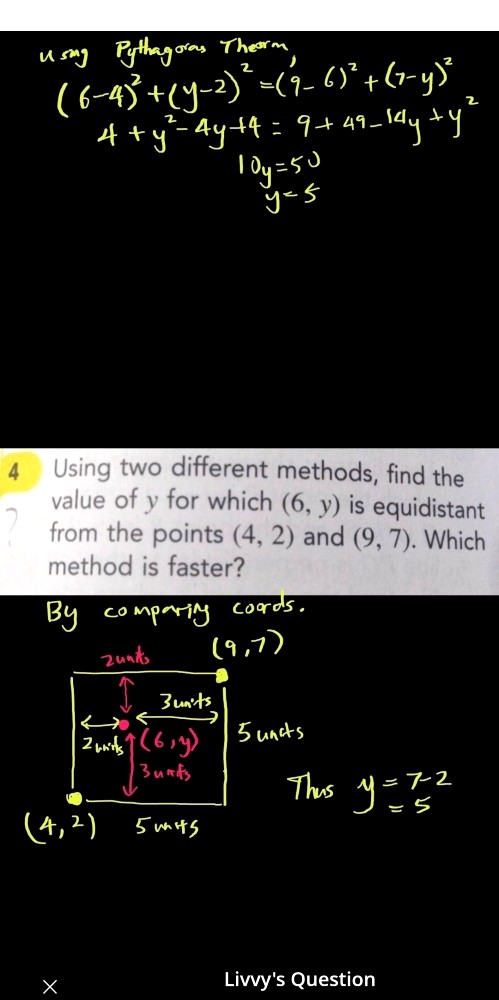Ask Singapore Homework?
Upload a photo of a Singapore homework and someone will email you the solution for free.

Question
secondary 3 | A Maths
One Answer Below
Anyone can contribute an answer, even non-tutors.

Coordinate Geometry
√[(6 - 4)² + (y - 2)²] = √[(6 - 9)² + (y - 7)²]
2² + (y - 2)² = (-3)² + (y - 7)²
4 + y² - 4y + 4 = 9 + y² - 14y + 49
y² - 4y + 8 = y² - 14y + 58
-4y + 14y = 58 - 8
10y = 50
y = 5
If (6,y) is equidistant from the two points, then we could draw a line from it to the midpoint of the line joining the two points.
The first line is the perpendicular bisector of the second. The product of their gradients must be -1.
Midpoint of (4,2) and (9,7)
Use formula ( (x1+x2)/2 , (y1+y2)/2 )
= ((4+9)/2 , (2+7)/2)
= (6.5,4.5)
Gradient of line joining (4,2) and (9,7)
Use formula (y2-y1)/(x2-x1)
= (7 - 2)/(9 - 4)
= 5/5
= 1
Gradient of perpendicular bisector
= -1 ÷ 1
= -1
So -1 = (y-4.5)/(6-6.5)
-1 = (y-4.5)/-0.5
-1 × (-0.5) = y - 4.5
0.5 = y - 4.5
y = 0.5 + 4.5
y = 5
The gradient of the line joining (6,y) and (4,2) is the reciprocal of the gradient of the line joining (9,7) and (6,y)
Eg. Something like 4/5 and 5/4
Their product = 1
(We already know the lines are not horizontal or vertical so there won't be any 0 or undefined gradients)
So,
(7 - y)/(9 - 6) × (y - 2)/(6 - 4) = 1
(7 - y)/3 × (y - 2)/2 = 1
(7 - y)(y - 2)/ 6 = 1
(7 - y)(y - 2) = 6
7y - 14 - y² + 2y = 6
y² - 9y + 20 = 0
(y - 4)(y - 5) = 0
y = 4
(rejected as their rise and run would be 3/3 and 2/2. This means they are not equidistant from (6,y) as one line is longer than the other)
or y = 5
See 1 Answer

Comparing coordinates is easy if the numbers are nice and if a simple diagram is needed, like in this case.
For this question, comparing coordinates is defintely easier. Hope this helps. Regards




